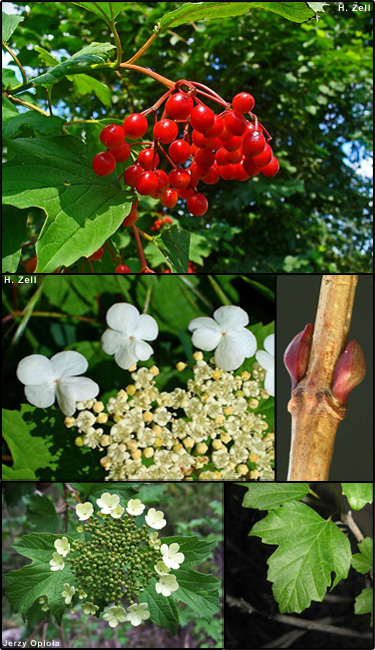European cranberrybush (Viburnum opulus)
 Synonyms: Viburnum opulus var. opulus, Viburnum roseum
Synonyms: Viburnum opulus var. opulus, Viburnum roseumCommon Names: European highbush cranberry, Guelder rose, viburnum
Description: Introduced to North America as an ornamental. Does not produce actual cranberries.
Habit: Light brown and stays largely smooth; multiple, arching tree/shrub; grows up to 10 ft tall.
Leaves: Opposite, simple, 3 lobed and coarsely serrated, orbicular, 2-4 in long, concave glands on petiole; dark green above, velvety below.
Stems: Tan to gray-brown; distinctly ridged; numerous lenticels; green to reddish brown buds are plump and have 2 visible scales.
Flowers: White in color, very showy, 1/2 in across, occurring in large clusters, outer ring of flowers sterile and larger, many cultivators have only sterile flowers; bloom in mid-spring.
Fruit and seeds: Fruit is a red berry, 1/4 inch drupe in clusters, ripening in late summer and persisting through the winter.
Habitat: Native to Europe, North Africa and Northern Asia.
Reproduction: By seed.
Similar species: American Cranberrybush (Viburnum opulus L. var. americanum); Mapleleaf Viburnum (Viburnum acerifolium).
Monitoring and rapid response: Hand-pulling or dug up of young seedlings; cut tree near ground level and apply glyphosate. Also eaten by the European Cranberrybush beetle. Credits: The information provided in this factsheet was gathered from the USDA PLANTS Database and Virginia Tech Department of Forest Resources and Environmental Conservation VTree.
Individual species images that appear with a number in a black box are courtesy of the Bugwood.org network (http://www.invasive.org).Individual photo author credits may not be included due to the small display size of the images and subsequent difficulty of reading the provided text. All other images appear courtesy of Google (http://images.google.com).
Common Name: | European cranberrybush |
Scientific Name: | Viburnum opulus |
Family: | Caprifoliaceae (Honeysuckle) |
Duration: | Perennial |
Habit: | Trees |
USDA Symbol: | VIOPO |
